The following guest post by Smut Clyde will show you many fake western blots. So far, so boring, but then again, this is why you came to this website, didn’t you? Also, it is not just the insolently massive scale of data fakery which is impressive, but also the scientists from Virginia Commonwealth University in Richmond, USA, themselves who published it.
Even in their official press release photos, the cancer research professors Paul B Fisher, Paul Dent and Steven Grant look like the characters of a Joel and Ethan Coen crime movie, unfortunately never filmed. Together these Virginian fortune seekers seem to have cooked up a scheme of getting rich by publishing fake science, which because of our utterly rotten and corrupted scholarly publishing and academic evaluation system worked so far like a charm. If trouble came, like an ORI investigation which recommended 11 retractions in 2015, one of the minor accomplices ended up in the metaphorical wood chipper, while the trio got to keep their coffers with funding money. And anyway, so far only 5 papers of who knows how many fake ones were retracted, while new research grants keep rolling in. It seems no pregnant village policewoman is there to stop the Dent, Grant and Fisher gang.
Years ago, when I was still allowed to comment on PubPeer, I had some interesting debates with Paul Dent. His last-author paper Yacoub et al Mol Pharmacol 2006 was flagged for problematic western blots, Grant and Fisher were co-authors. A lane with a band was indisputably spliced in:
 Yet Dent explained:
Yet Dent explained:
“The data in Panel D was NOT cut and paste; that’s just the way the lanes ran. The vehicle values in Panel E are the same because the postdoc took a baseline time = 0 value. Which iwas used as the control value for both time points. Paul Dent”
This was the Panel E he mentioned, bands were copy-pasted:
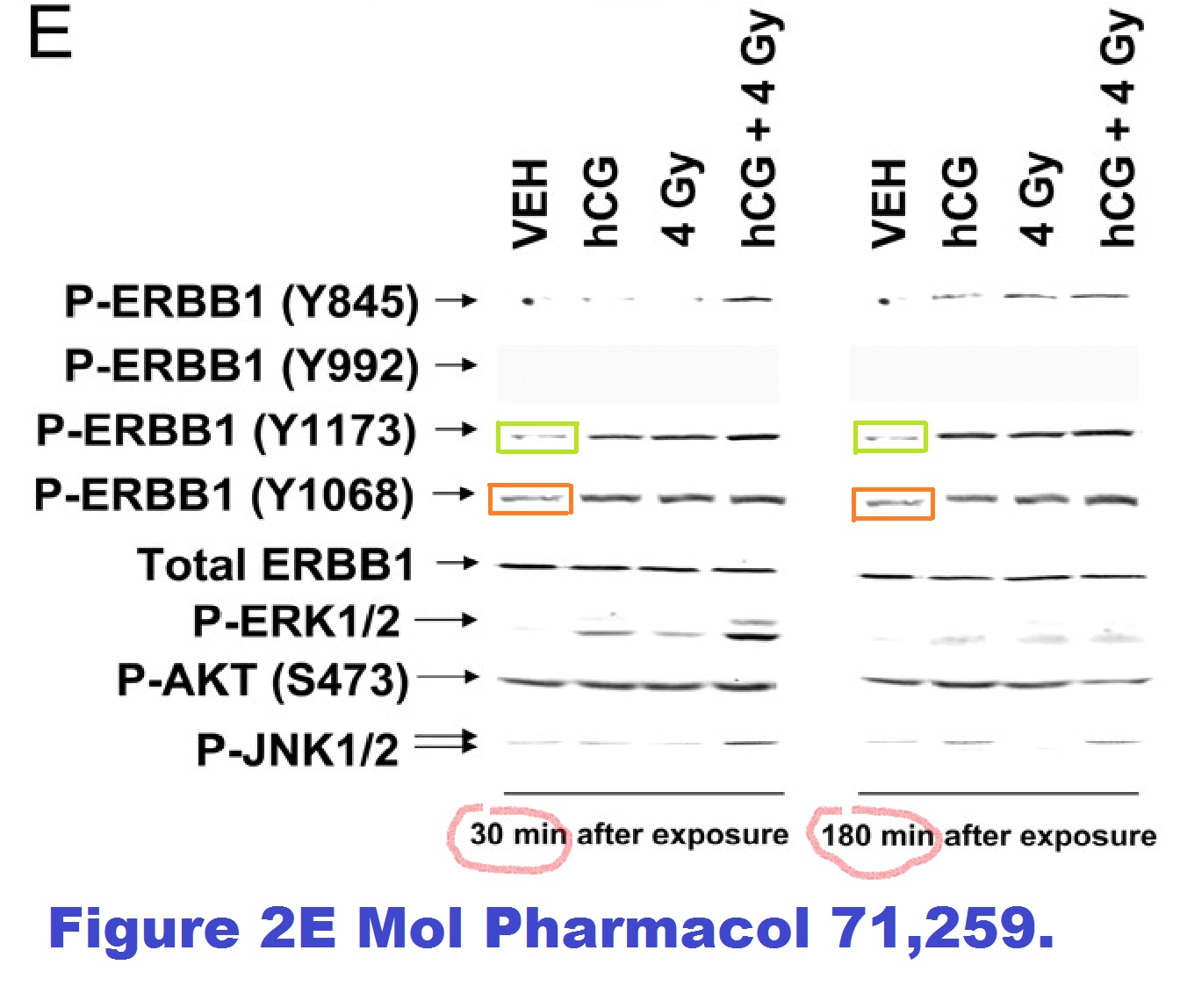
Very soon, Dent admitted to have falsified the figure fimself, and offered a retraction:
“As I recall the postdoc ran one vehicle control. That image was duplicated and the duplicate placed alongside the data from each time point for comparison purposes. I was the person who did that, I freely admit. However, I was in no way attempting to “intentionally manipulate the data”…. I simply duplicated the control value and placed it alongside the images of how the various treatments changed band intensity for the reader to more easily compare between control and treated. If that is classified truly as scientific misconduct then I hold my hands up. But that was in no way my intention. If you wish me to write to The Journal and retract the entire manuscript, I will do so.”
Only that was a fib, most likely posted by Dent on PubPeer to stop people from analysing his papers further. The Yacoub et al 2006 paper was never retracted, a year later the authors issued instead a correction in August 2016:
“It has been pointed out to us that the control 0 min time point bands in Figure 2E were duplicated. The control lanes were purposefully placed as duplicates for illustrative purposes, and the Figure Legend inadvertently neglected to mention this. To remedy this issue, these and related experiments corresponding to Figure 2D(i) and Figure 2E of the original manuscript were repeated and the new data are shown here as Panel A and Panel B, respectively.
In Panel A (corresponding to Figure 2D(i)), we observe that hCG increased ERBB1 Y1173 phosphorylation over a 2h time course that was very similar to the originally published data. The ERBB1 Y845 phosphorylation also exhibited a similar pattern of phosphorylation, though the level of increased phosphorylation did not exhibit as high a peak at 60 min and at 90 min as was presented in the originally published data. […]”
This was the teaser of a Dent-Grant-Fisher movie in the nutshell.

To lose one co-author’s papers to an ORI investigation may be regarded as a misfortune; to lose two looks like carelessness. By Smut Clyde
A University of Kentucky cancer toxicologist with a history of retractions is back under investigation, as recently reported in his local press. I have nothing to contribute except to link the case to another of Xianglin Shi’s papers, which spawned a long-standing thread at Pubpeer, where the insouciant disregard of the editors of Blood reduced “Peer 2” to a state of agitated despair about the paper Gao et al 2006:
“Can someone please wake me up from this nightmare?
How is this possible? They are everywhere, I stopped after these ones but there are probably more.
I have contacted VCU several times regarding the seemingly endless issues like the ones pointed out here, but still no action.
Have I misunderstood something? Maybe it is not science after all but an advanced form of “Where is Wally” VCU scientist are publishing?”
Peer 2 was referring to the duplicated image elements, which swarm and pullulate through the paper like leit-motifs in a Wagner score, like rabbits in the marginalia of an illuminated manuscript, binding the separate Figures together in an intricately-woven web of synchronicity. It is difficult to know where to begin. Anyone trying to annotate all the replications runs quickly out of colours.
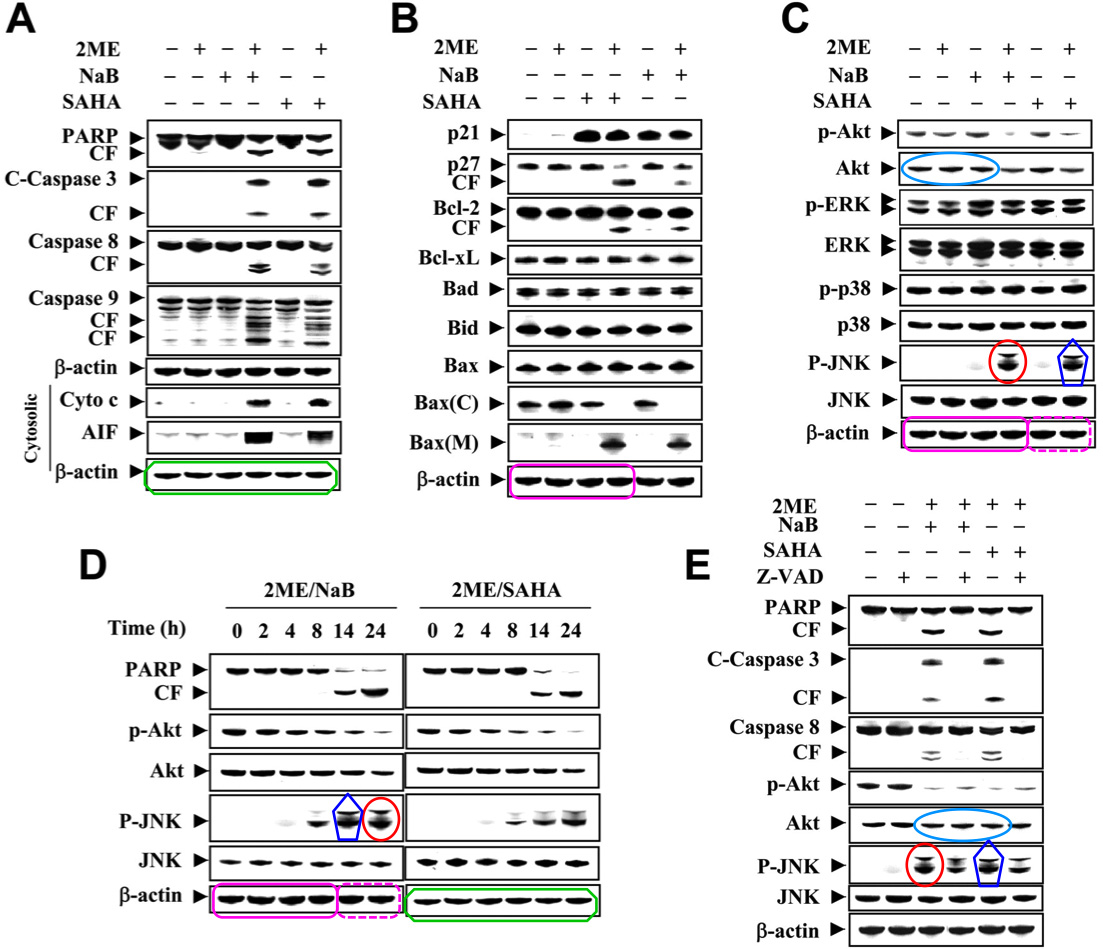

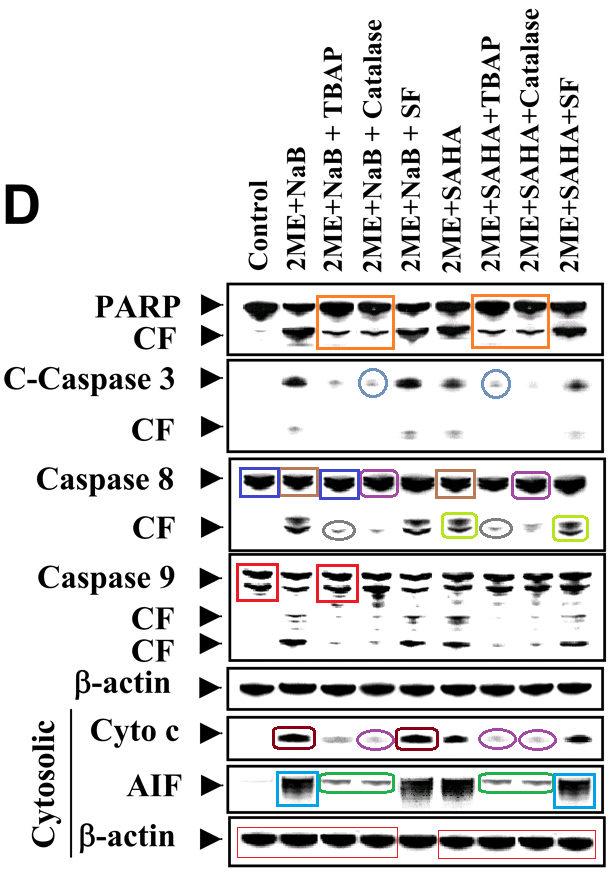
The last time I saw so many mascara eyelashes together in one place was at a Siouxsie and the Banshees concert.
Our real focus here is Shi’s co-authors on this dubious paper, Professors Paul Dent and Steven Grant of Virginia Commonwealth University, where (along with Paul B. Fisher) they form a troika of cancer-research excellence. Their careers are resplendent with publications and scientific honours. I worry, though, that between receiving those honours and editing journals and the endless cycle of grant applications, they have little time left to spend supervising their students or carefully reading all the papers they sign.
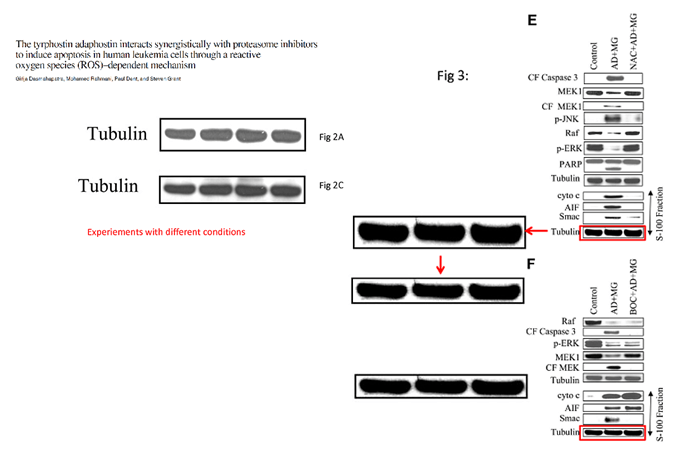
The above shown Dasmahapatra episode, for instance, was not a shining display of thorough mentoring and oversight. Girija Dasmahapatra confessed to faking results in eleven Dent / Grant collaborations from 2005 to 2014 [RW] and was subsequently thrown under the bus… or thrown to the wolves… or thrown to the wolves under the bus. It may be that Dent and Grant have really terrible luck with their co-authors.
“All of the 11 affected papers will be corrected or retracted, according to the ORI notice.[…]
ORI found that Respondent falsified and/or fabricated data by reporting the results of Western blot experiments and mouse imaging experiments that examined interactions between multiple histone deacetylase and/or proteasome inhibitors in several cancer models. Specifically, Respondent duplicated, reused, and/or relabeled Western blot panels and mouse images and claimed they represented different controls and/or experimental results…”
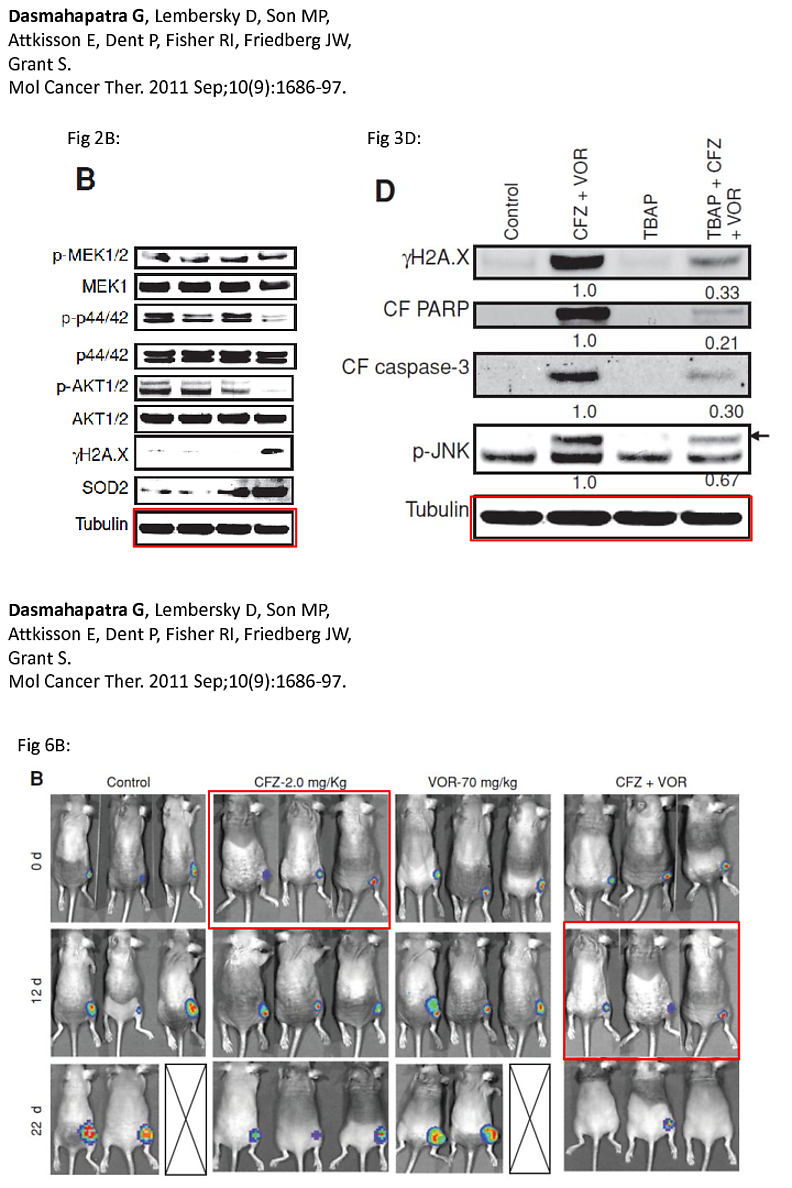
The Dent / Grant oeuvre is of interest to us as encapsulating in microcosm the current biomedical research paradigm, with its feudal hierarchies of PIs and grad-student lab-bench serfs, and the perverse structural incentives which motivate Principal Investigators to minimize the time they spend on the investigations they are principalling. No-one really needs yet another cautionary tale of “How Laboratory Culture Goes Wrong”, no more than anyone wants another exhaustive gallery of re-used or manipulated Western blots, but that is what you get.
Grant and Dent’s productivity (and Fisher’s) caught the attention of the vast and cool and unsympathetic intellects who comment at PubPeer, with the list of separate threads currently numbering in the 50s. Those threads hint at a general disenthusiasm in the laboratory ethos for farfing around with loading controls in gel-electrophoresis probes (to prevent accidental or unconscious variations in aliquots from skewing the results)… with a belated realisation that reviewers do expect controls, requiring improvised gap-fillers. Thus, from 2004, “Synergistic induction of oxidative injury and apoptosis in human multiple myeloma cells by the proteasome inhibitor bortezomib and histone deacetylase inhibitors” (Pei, Dai and Grant, Clin Cancer Res 2004, PubPeer here):

“The loading control is Tubulin three times and Actin once. It has six lanes on two occasions and five lanes on the other two (losing Lane 2). It controls for different conditions that result in three different PARP / CF slices, three different Mcl-1 and XIAP slices, etc.”
2004 was an Annus Mirabilis. New students joined the team, and we were treated to confections like these, from “Contribution of disruption of the nuclear factor-kappaB pathway to induction of apoptosis in human leukemia cells by histone deacetylase inhibitors and flavopiridol” (Gao et al Mol Pharm 2004, PubPeer here):

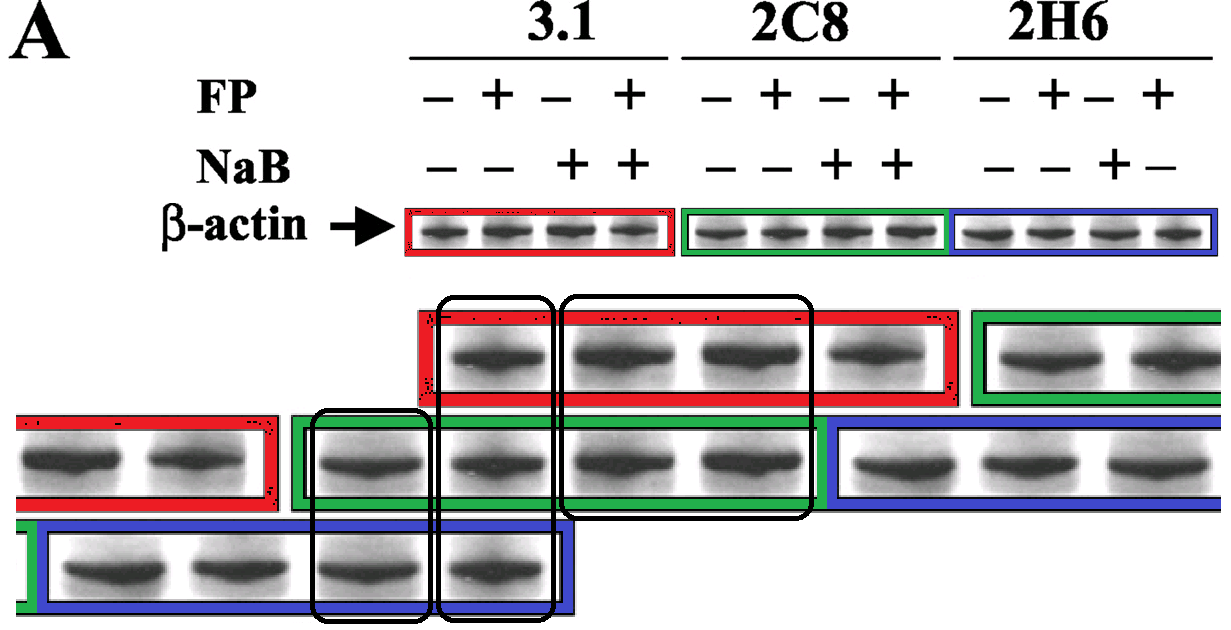
These may look as if Mondrian hurt his head falling downstairs but continued to paint while experiencing temporal-lobe seizures, but the goal is to illustrate how generic slices of gel, each containing seven lanes, each provided loading controls for a series of four-lane blots by shifting the read frame. More crucially, more substantive non-control parts of other Figures (such as the C-Caspase-3 panels of Fig 5A) also turn out to be fabricated. Apparently, the authors used 3 different exposures of same blot to stand in for 3 different experiments; still unhappy that the figure was not sufficiently fake yet, they adjusted and replaced some bands in Photoshop.

Many of these demonstrations require adjustments to the contrast and lightness of the as-published Figures. This sheds a cruel, unflattering light, especially on older illustrations. To leap ahead to “Mechanism of in vitro pancreatic cancer cell growth inhibition by melanoma differentiation-associated gene-7/interleukin-24 and perillyl alcohol” (Lebedeva et al Cancer Res 2008, PubPeer here), the backgrounds of Figures 1B and 4D do not look at all realistic when treated so harshly:


Returning to earlier in the Dent / Grant corpus, “2-Methoxyestradiol-induced apoptosis in human leukemia cells proceeds through a reactive oxygen species and Akt-dependent process” (Gao et al Oncogene 2005, PubPeer here) is another rich source of improvised loading controls.

“Figures 7d, 7e have their own loading control, but by this point in the paper, the authors had stopped caring very much.”
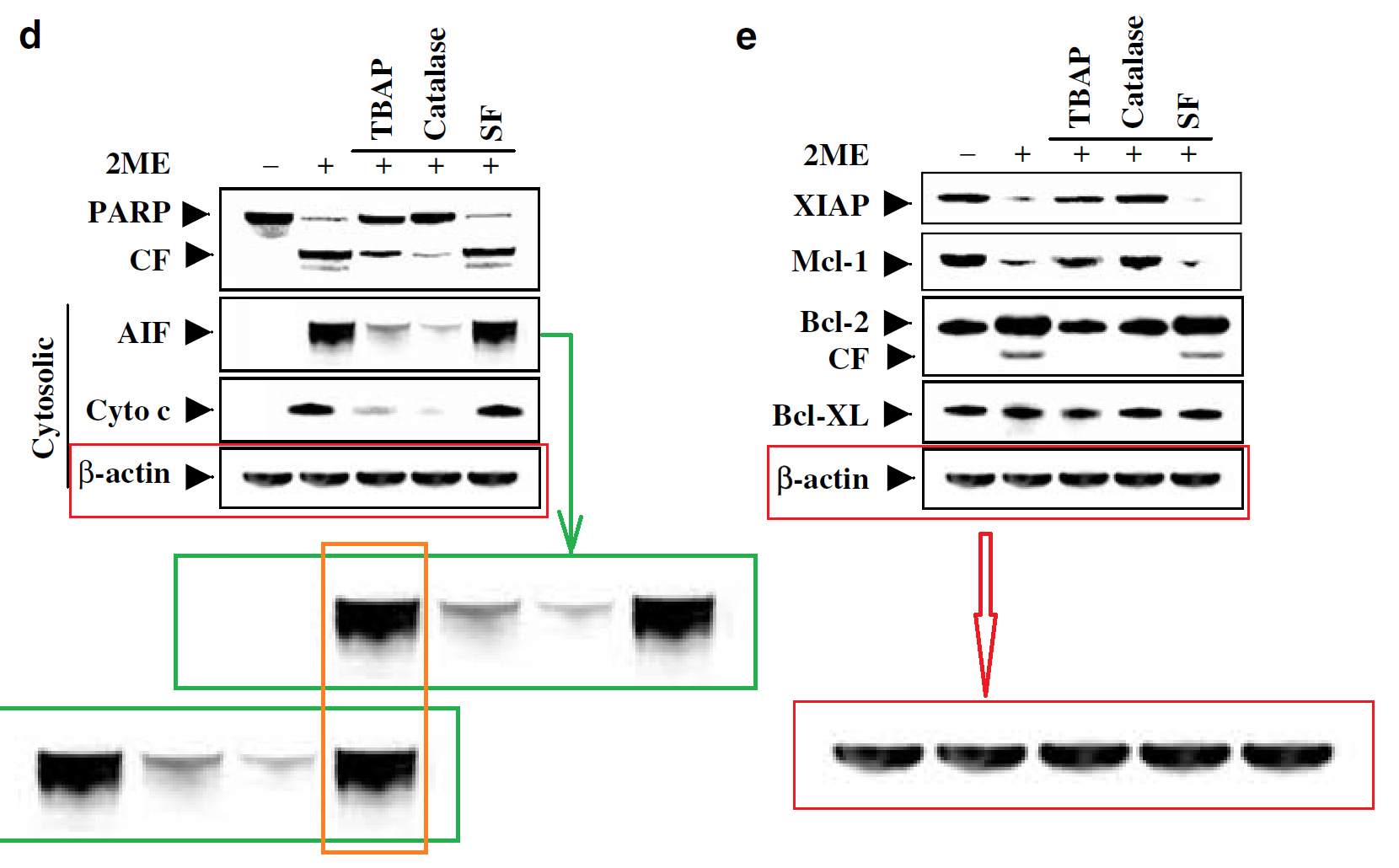
The protein blobs in other, non-control panels of these Figures display the same impressive consistency of shape. Recurring visual motifs follow a cetacean theme, with a sperm-whale in profile, a whale tail, an oil-lamp. Are there special stencils or pipette tips one can use to standardise the shapes of aliquots when adding them to the wells?
Recurrent blobs are also prominent throughout “The three-substituted indolinone cyclin-dependent kinase 2 inhibitor 3-[1-(3H-imidazol-4-yl)-meth-(Z)-ylidene]-5-methoxy-1,3-dihydro-indol-2-one (SU9516) kills human leukemia cells via down-regulation of Mcl-1 through a transcriptional mechanism” (Gao et al Mol Pharmacol 2006, PubPeer here). Each Figure is a hiding-place for Easter Eggs, while the loading controls appear to have been assembled from IKEA kitsets.

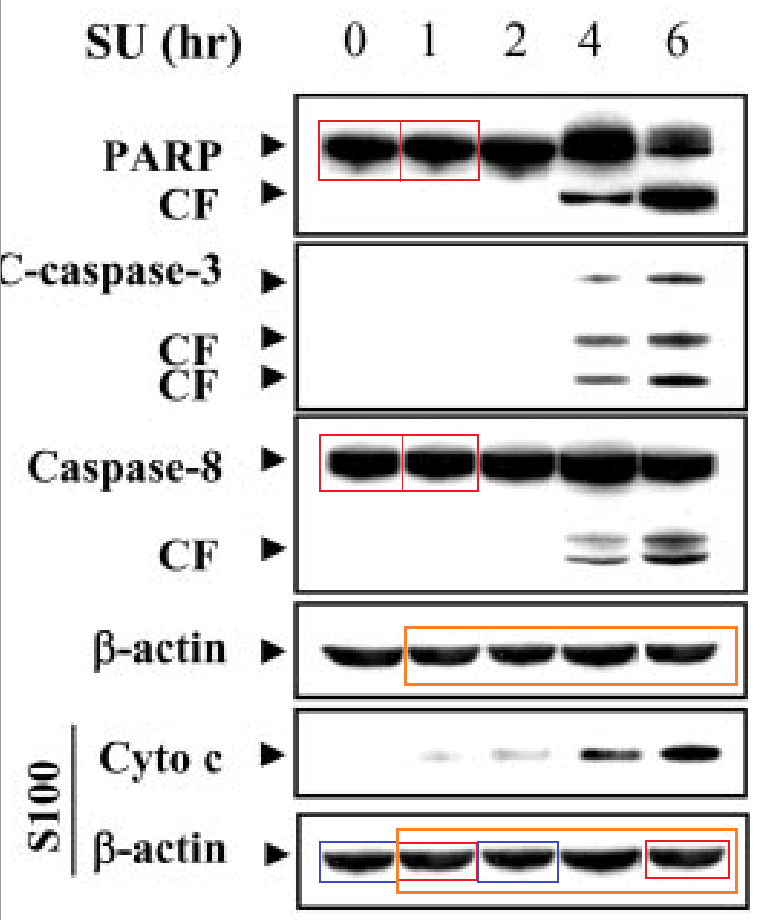
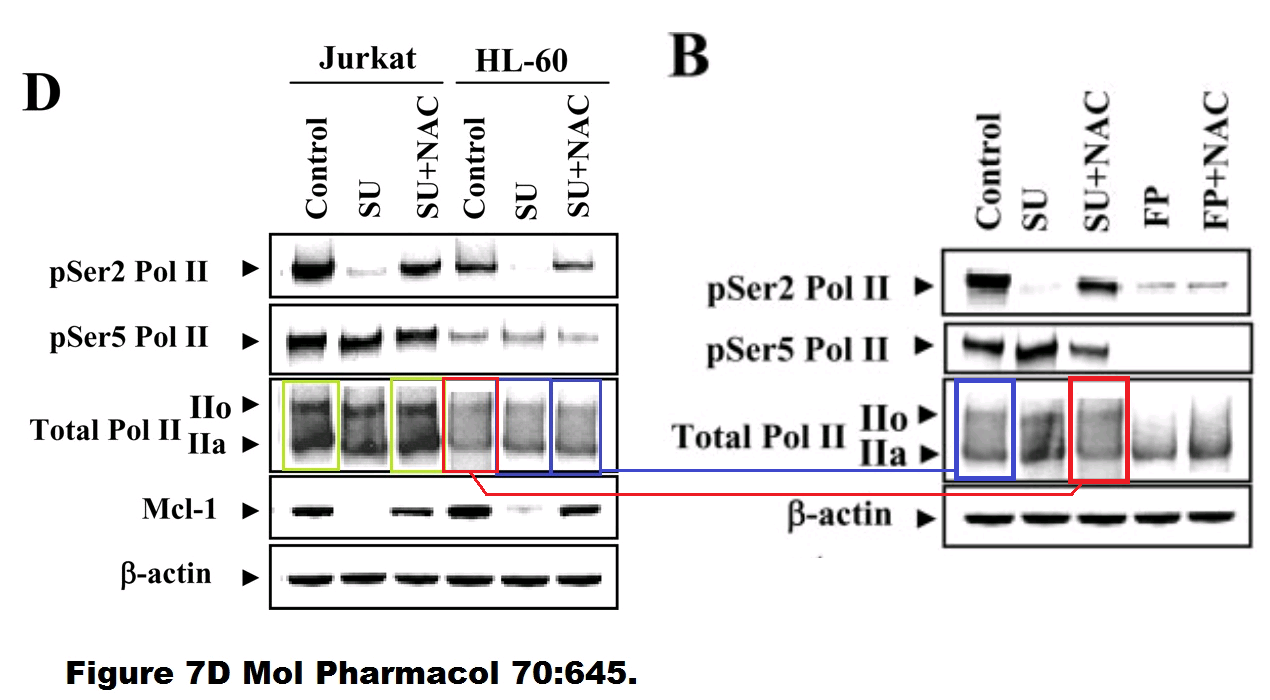
There are earlier entries in this PubPeer corpus dating back to 2000-2003, raising concerns involving pictorial similarities and discontinuities… these could be clues to duplication or splicing, but could just be artifacts (the image quality is not always ideal, with Western blots seemingly viewed through a shimmering gauzy scrim, or photocopied and rephotographed, or printed on newsprint as half-tones and then sent via fax). It is time to remind ourselves that the mere number of papers flagged at PubPeer is not decisive, for comments there can be trivial or misguided.
Some of the queries, in fact, could easily be motivated by the critics’ need for completeness, and the authors could be forgiven for feeling persecuted, or hounded, as if their names were Clinton. Initially they responded to the critiques:
I agree I cannot explain the straightness of the p41 images, they look too straight to me too. I know I have seen this issue before on some of the digital material from some postdocs and have always assumed it was simply the way the gel ran. However, as I pointed out, I was not paying much attention to p41 for “quality issues” as the data set from which scientific conclusions are drawn is p31 / p25.
Those responses hinted at a hands-off approach to supervision of the student researchers. Leonid Schneider probably did not help.
Dear Dr. Dent, if your statement is true, your postdocs are playing terrible tricks on you. It is a pity that you as professor at the Dept. of Biochemistry & Molecular Biology apparently don’t have sufficient experience in this western blotting technology to help you recognise manipulation. Please enlist yourself and your employees in courses on good scientific practice as soon as possible.
Leonid Schneider
(from “OSU-03012 stimulates PKR-like endoplasmic reticulum-dependent increases in 70-kDa heat shock protein expression, attenuating its lethal actions in transformed cells“: Park et al Mol Pharmacol 2008, PubPeer here).
But evidently the experience was not rewarding. The authors came to view PubPeer was a louche, improper forum and lost their enthusiasm for engagement with its insatiable and incorrigible commentariat.
In this case – “Apogossypol derivative BI-97C1 (Sabutoclax) targeting Mcl-1 sensitizes prostate cancer cells to mda-7/IL-24-mediated toxicity” (Dash et al PNAS 2011, PubPeer here) – concerns about the problematic Figure 4C were rendered moot by a Correction, though it didn’t really explain how the original weird hybrid came to exist.
Anyway, this survey of the corpus is fortunately not intended to follow a chronological sequence. We have already imposed some structure on the sprawling literature by distinguishing a ‘Dasmahapatra’ period within it, much as one organises the catalog of a heavy-metal band according to replacement drummers or bassists. Similarly we might recognise a ‘Rosato’ period… Roberto Rosato appears as co-author in 13 PubPeer threads in the oeuvre from 2002 to 2012, accounting for two Retractions and an Erratum. A VCU spokesperson advised RetractionWatch that “The article’s first author, Roberto Rosato, left VCU in 2010.”
This sub-corpus deserves to be explored at length, but we can only mention a few highlights – like the eight-lane kitset-assembled loading strip used to control for nine lanes of the protein of interest, in “Mechanism and functional role of XIAP and Mcl-1 down-regulation in flavopiridol/vorinostat antileukemic interactions” (Rosato et al Mol Cancer Ther 2007, PubPeer here).
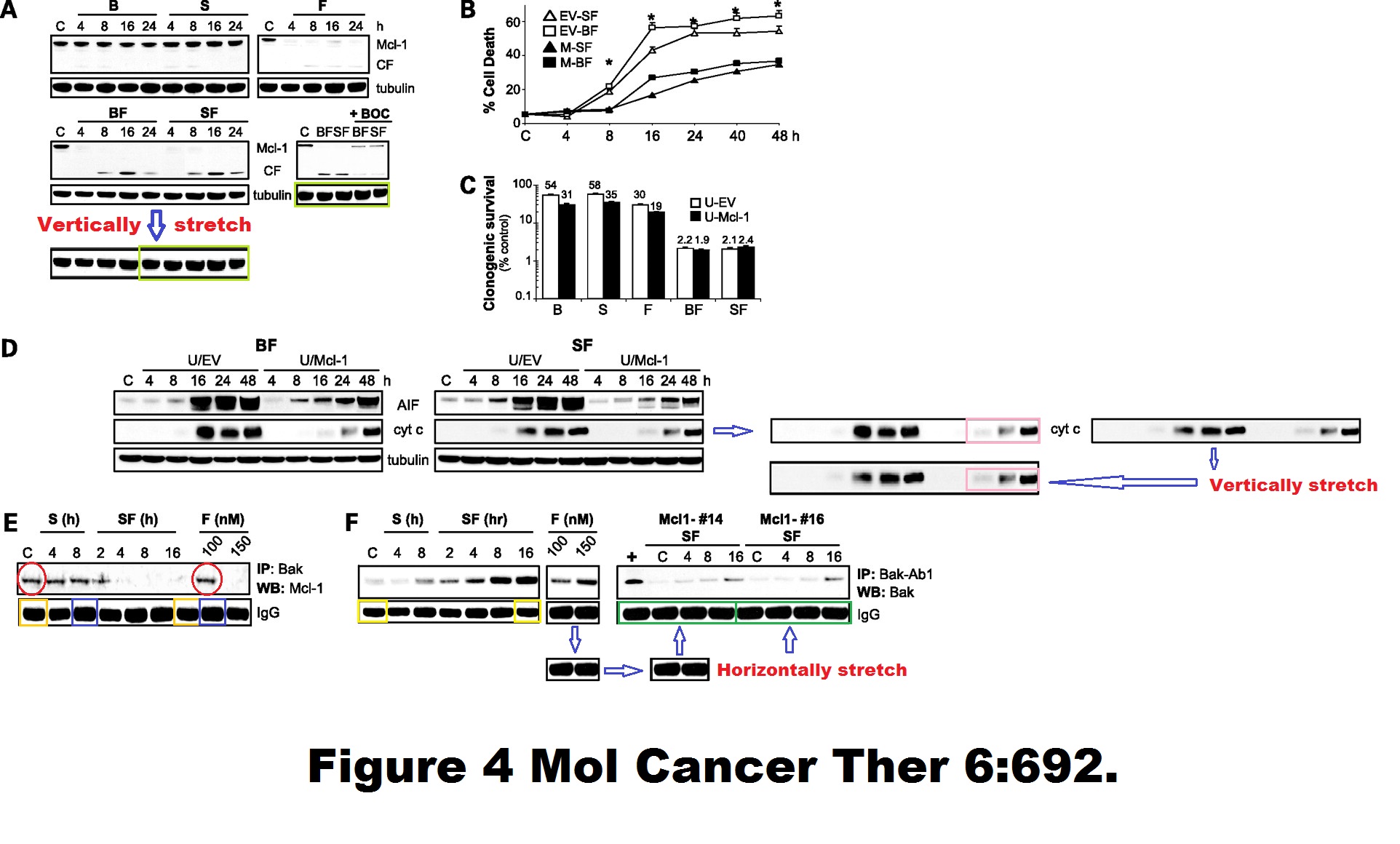
Perhaps this was to compensate for Fig 6D in “Potentiation of the lethality of the histone deacetylase inhibitor LAQ824 by the cyclin-dependent kinase inhibitor roscovitine in human leukemia cells” (Rosato et al Mol Cancer Ther 2005, PubPeer here), in which a ten-lane Actin loading strip controlled for nine bands of the proteins of interest.

In the manner of kaleidoscope aesthetics, a repertoire of graphical elements served to illustrate a sequence of observations by rearranging them into new combinations.


Again, commentators were reduced to an abyss of abject despair:
So we turn quickly to “LBH-589 (panobinostat) potentiates fludarabine anti-leukemic activity through a JNK- and XIAP-dependent mechanism” (Rosato et al Leukemia Res 2012, PubPeer here):
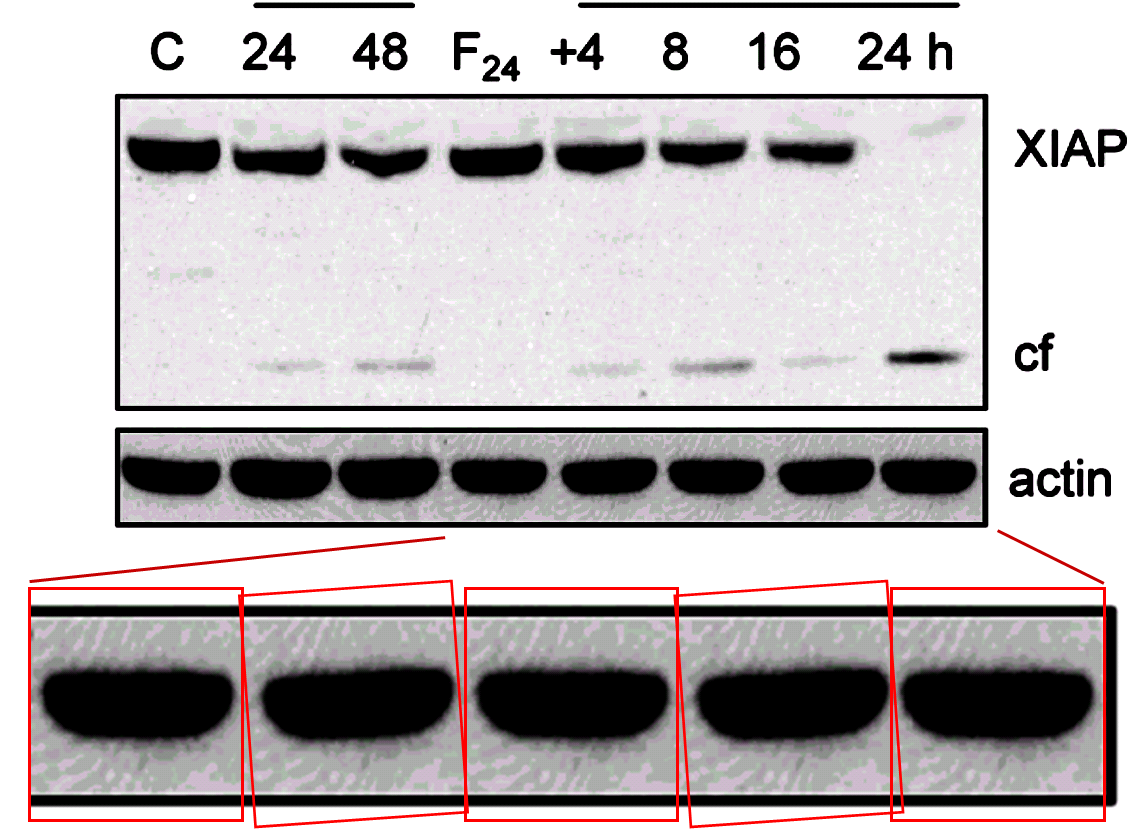
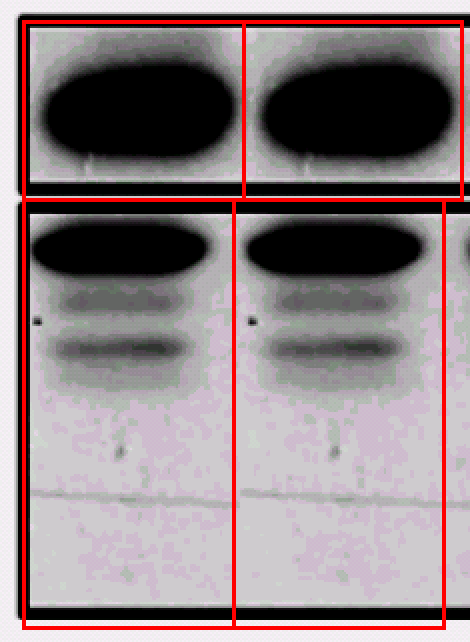
Accidental conversion of a bit of Western Blot to ‘tubulin’ or ‘actin’ or ‘EF-1α’ could happen to anyone… but when images have been fabricated, or manipulated to substitute for bona fide documentation of an experiment, it undermines ones’ faith in the substantive claims.
I originally set out to include Prof. Paul B. Fisher of VCU in this strip-mining survey of PubPeer threads, but space does not permit. As well as co-authorship on 22 entries of the Dent / Grant corpus, he has his own oeuvre of 15 non-overlapping entries. Perhaps there could be a sequel if the readers clamour for one. To pique your interest and whet your appetites, Condylocarpon amazonicum an anonymous Peer prepared some diagrams.



They look like a coloured-arrow factory exploded but they are intended to show the reuse of Blots and cell-culture images within and between a trilogy of papers. One Figure has six panels of cells under different conditions but after taking account of all the reflections, rotations and enlargements, these prove to be overlapping details of only two source microphotographs.
“mda-9/Syntenin regulates the metastatic phenotype in human melanoma cells by activating nuclear factor-kappaB” (Boukerche et al Cancer Res 2007, PubPeer here);
“mda-9/Syntenin promotes metastasis in human melanoma cells by activating c-Src” (Boukerche et al PNAS 2008, PubPeer here);
“Src kinase activation is mandatory for MDA-9/syntenin-mediated activation of nuclear factor-kappaB” (Boukerche et al Oncogene 2010, PubPeer here).
First author on all three, Habib Boukerche, has his own PubPeer presence (and a retraction). Any sequel could also look at the accomplishments of frequent Grant / Dent / Fisher collaborator Devanand Sarkar… stepping-stones to his current eminence as Distinguished Professor, Endowed Scholar and Director of Education & Training at VCU.
Surely all these cannot be wrong?
https://www.massey.vcu.edu/news/blog/2014/paul-fisher-honored-as-scientist-of-the-year/
As for those 11 Dasmahapatra papers, and the ORI report three years ago that interested parties agreed that they were unsustainable, three have been retracted. Extrapolating this rate, the last one will be amended or withdrawn from the literature by 2027. Currently eight of them continue to be read and to accrue citations while other cancer researchers design their own investigations around them, for there is nothing to warn the unwary reader of their false-data nature, not even an Expression of Concern. The reasons for this editorial inaction at Blood and Molecular Cancer Therapeutics are unfathomable.

Donate!
If you are interested to support my work, you can leave here a small tip of $5. Or several of small tips, just increase the amount as you like (2x=€10; 5x=€25). Your generous patronage of my journalism will be most appreciated!
€5.00


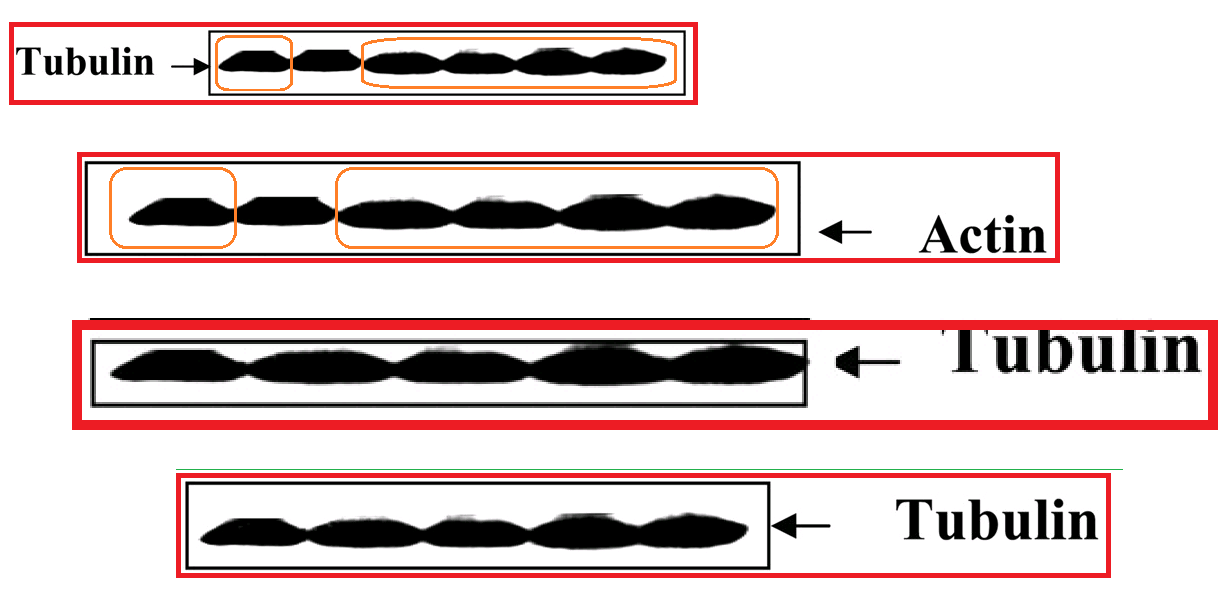
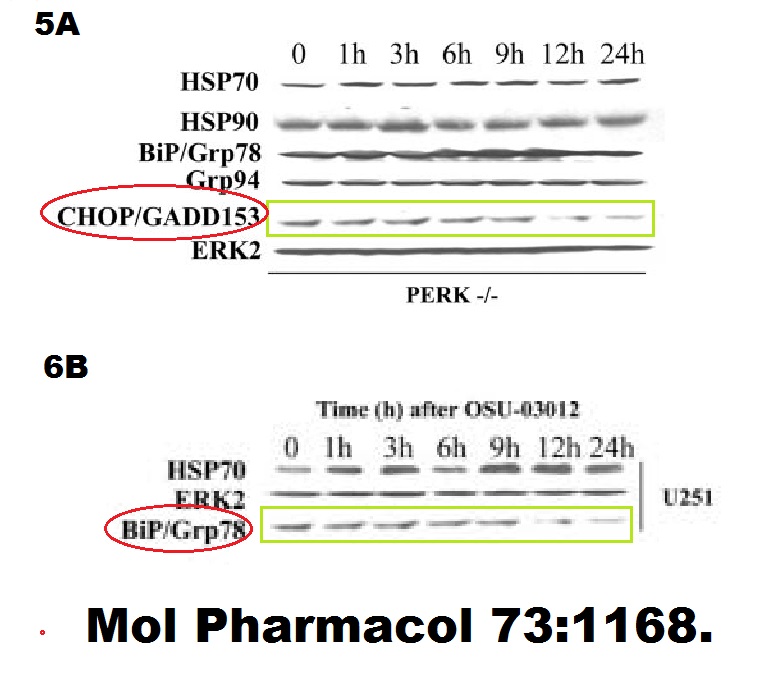
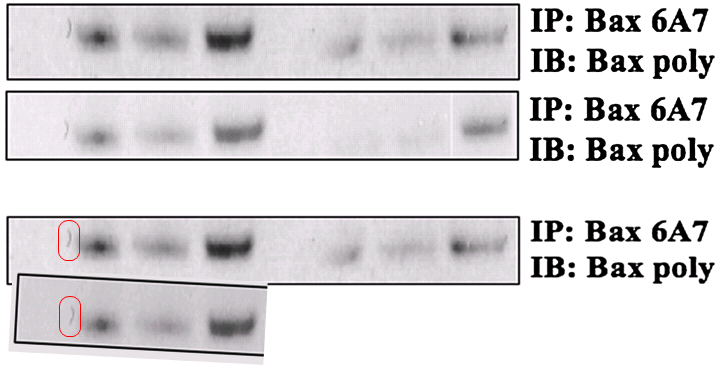


An early paper in the Paul fisher trail (first commented April 14th, 2014 6:37 PM and accepted April 14th, 2014 6:37 PM)
is this one: https://pubpeer.com/publications/C6FE2754472A7CB4EEE510FC03D1F3
http://cancerres.aacrjournals.org/content/72/23/6217.article-info
Swadesh K. Das1,2, Sujit K. Bhutia1, Upneet K. Sokhi1, Belal Azab1, Zhao-zhong Su1, Habib Boukerche4, Talha Anwar5, Erika L. Moen5, Devasis Chatterjee5, Maurizio Pellecchia6, Devanand Sarkar1,2,3, and Paul B. Fisher1,2,3
Authors’ Affiliations: 1Department of Human and Molecular Genetics, 2VCU Institute of Molecular Medicine, 3VCU Massey Cancer Center, Virginia Commonwealth University, School of Medicine, Richmond, Virginia; 4EA 4174, University Claude Bernard, Lyon 1, INSERM, Lyon, France; 5Department of Medicine, Rhode Island Hospital, Providence, Rhode Island; and 6Sanford-Burnham Medical Research Institute, La Jolla, California
which leads to another tree of publications at Pubpeer:-
https://pubpeer.com/search?q=devasis+chatterjee
This one came to attention in 2013: https://pubpeer.com/publications/6105B398EDE6602E12C6068FF08F79
(first commented September 13th, 2013 7:25 PM and accepted September 13th, 2013 7:25 PM, and is still yielding Easter eggs).
Should this be termed a “cross-over event”?
LikeLike
Devasis Chatterjee tree has several “cross-over events” with more extensive Benjamin Bonavida tree: https://pubpeer.com/search?q=bonavida
4 retractions for this network of authors:-
https://pubpeer.com/publications/A83B36EFFF43B626C3C54DB52F00A4
https://pubpeer.com/publications/73EA8CDE2B3E8AF2207FEFA8D2E4C2
https://pubpeer.com/publications/FF771F6D16ADB90D7F8C11E5361A1F
Retraction RKIP protein
https://pubpeer.com/publications/B657BAB5E08B48AE06A645E366618D
https://retractionwatch.com/2016/12/13/ucla-lab-pulls-two-papers-one-author-admitted-misconduct/
https://retractionwatch.com/2017/07/20/drip-drip-ucla-investigation-finds-image-duplications/
The link with Paul Fisher was also about the RKIP protein,
https://pubpeer.com/publications/C6FE2754472A7CB4EEE510FC03D1F3
Retraction RKIP protein other side of Atlantic.
https://pubpeer.com/publications/C3F027A05FE0D39D2C94584448DF3E
http://retractionwatch.com/2017/04/13/three-figures-blood-pressure-paper-manipulated-says-journal/
Is there a faulty RKIP sub-routine?
LikeLike
Nice to see editor of ScienceDaily being taken in hook line and sinker as recently as March this year (2019).
https://www.sciencedaily.com/releases/2019/03/190325130533.htm
This statement does not seem to be correct “More than a decade of research on the mda-7/IL-24 gene has shown that it helps to suppress a majority of cancer types…”
You’d think that the editor would have looked at Pubpeer:-
https://pubpeer.com/publications/B65F369F8DE1911234C0EF33A8C500
https://pubpeer.com/publications/57A44E5E877F35C0D9ADC9C17BFCFE
https://pubpeer.com/publications/637AE1E284EBFA3DC7BC644563E142
https://pubpeer.com/publications/770A7D14B551E7C1FE1F0B388D17BA
https://pubpeer.com/publications/585F1DCD4BE6D3CAE7A52F5EBDE10C
https://pubpeer.com/publications/92BC6A094F87FE5FCE866EA7713679
https://pubpeer.com/publications/907A680B96720F3A16562918252899
https://pubpeer.com/publications/C3731FFE4E99A4D434A4A2A569BA9C
It is already laid out on a plate, how come he didn’t notice anything the matter?
Is Science Daily anything more than a gormless cheerleader for biotech?
LikeLike
I am deeply concerned regarding any clinical trials initiated based on the work by this troika.
Now that VCU has been warned several times and have got presentations which illustrates the
fakery, I would guess they can be sued by patients or collaborators in the future if they don’t stop
trials they should know are based on fraud.
I am also wondering if it could be possible with a class action lawsuit where researchers that have lost time
and money by reading this shit and following up the fraud? I spent some hours reading several of the
Dasmahapatra papers before I noticed some problematic issues and reported it to VCU. Many of the
problematic papers are cited quite many times so many researchers are affected.
LikeLike
One of Paul Fisher’s underling’s, Habib Boukerche, went back to France and tried to do the same. The paper was retracted. Second retraction here:
https://retractionwatch.com/2015/11/06/authors-withdraw-two-papers-from-jbc-and-thats-all-we-know/
His institutional webpage no longer works, and according to Pubmed Boukerche H has not published since that retraction.
https://www.ncbi.nlm.nih.gov/pubmed/?term=boukerche%20h
That retraction was in 2015. Didn’t VCU put 2 and 2 together?
LikeLike
Classic. I enjoyed this with a nice coffee at home and am looking over some of the frankengels with a cozy tea right now. I did have a bit of panic when I realized that I recently made some shit for the biologists that they are injecting into cells, and they did some voodoo biology stuff and now I’m a coauthor there… but they promised no funny business. Nobody would accuse a poor, harmless chemist of anything, would they?
Our culture is still not at the Pubpeer level. We just write new papers and accuse the fabricated figures of the faker of raising ‘intriguing questions in the contents, as in the following: https://pubs.acs.org/doi/abs/10.1021/acs.organomet.9b00083
LikeLike
Many important discoveries were supported by southern, northern and western blots. These techniques should be compulsorily automated and the raw data compulsorily published.
LikeLike
Pingback: The good life of Benjamin Bonavida – For Better Science
Pingback: When gel bands go marching in, by Elisabeth Bik – For Better Science
3 June 1st, 2019 Retractions
Retraction: Carfilzomib Interacts Synergistically with Histone Deacetylase Inhibitors in Mantle Cell Lymphoma Cells In Vitro and In Vivo
Girija Dasmahapatra, Dmitry Lembersky, Minkyeong P. Son, Elisa Attkisson, Paul Dent, Richard I. Fisher, Jonathan W. Friedberg and Steven Grant
Mol Cancer Ther June 1 2019 18 (6) 1179-1179; DOI:10.1158/1535-7163.MCT-19-0469
Retraction: Obatoclax Interacts Synergistically with the Irreversible Proteasome Inhibitor Carfilzomib in GC- and ABC-DLBCL Cells In Vitro and In Vivo
Girija Dasmahapatra, Dmitry Lembersky, Minkyeong P. Son, Hiral Patel, Derick Peterson, Elisa Attkisson, Richard I. Fisher, Jonathan W. Friedberg, Paul Dent and Steven Grant
Mol Cancer Ther June 1 2019 18 (6) 1180-1180; DOI:10.1158/1535-7163.MCT-19-0470
Retraction: In Vitro and In Vivo Interactions between the HDAC6 Inhibitor Ricolinostat (ACY1215) and the Irreversible Proteasome Inhibitor Carfilzomib in Non-Hodgkin Lymphoma Cells
Girija Dasmahapatra, Hiral Patel, Johnathan Friedberg, Steven N. Quayle, Simon S. Jones and Steven Grant
Mol Cancer Ther June 1 2019 18 (6) 1181-1181; DOI:10.1158/1535-7163.MCT-19-0471
LikeLike
https://retractionwatch.com/2019/06/05/why-did-all-of-these-retractions-take-more-than-three-years/
“But since the ORI report, the nine papers retracted or corrected this year have been cited more than 80 times. That’s more than 80 papers that relied, at least in some small part, on faked studies in Blood, Cancer Biology & Therapy, Leukemia Research, Molecular Cancer Therapeutics, Molecular Pharmacology, and the British Journal of Haematology.”
LikeLike
Pingback: The return of David Latchman Show – For Better Science
Pingback: Sanofi R&D Head John Reed knows how to science – For Better Science
Pingback: Editorial gatekeepers mind their own goals – For Better Science
2019 Editor’s Note.
https://cancerres.aacrjournals.org/content/79/19/5127
The editors were made aware of several concerns pertaining to Figs. 1, 2, and 4 in this article (1). The Western blot images in Figs. 1 and 4 were prepared based on the acceptable standards at the time of submission. In Fig. 2C, duplicate migration/invasion assay images were used to represent different experimental conditions. Due to the length of time since publication of this article, original data are not available to correct the figures in this paper, and the editors are publishing this note to alert readers to these concerns.
Reference.
Cancer Res. 2005 Dec 1;65(23):10901-11.
mda-9/Syntenin: a positive regulator of melanoma metastasis.
Boukerche H1, Su ZZ, Emdad L, Baril P, Balme B, Thomas L, Randolph A, Valerie K, Sarkar D, Fisher PB.
Author information
1
Department of Pathology, Columbia University Medical Center, College of Physicians and Surgeons, New York, New York 10032, USA.
“duplicate migration/invasion assay images were used to represent different experimental conditions”. When was this ever acceptable standards?
Pubpeer: https://pubpeer.com/publications/6CC433A666E1C94DC3F6F66E147C37
LikeLike
Proc Natl Acad Sci U S A. 2007 Feb 27;104(9):3484-9. Epub 2007 Feb 21.Strategy for reversing resistance to a single anticancer agent in human prostate and pancreatic carcinomas.Lebedeva IV1, Washington I, Sarkar D, Clark JA, Fine RL, Dent P, Curiel DT, Turro NJ, Fisher PB.Author information1Department of Urology, Herbert Irving Comprehensive Cancer Center, College of Physicians and Surgeons, Columbia University, New York, NY 10032, USA.
Figure 4. Much more similar and different than you would expect.
LikeLike
Proc Natl Acad Sci U S A. 2007 Feb 27;104(9):3484-9.
Paul B Fisher, 1 of 2 corresponding authors, refers matter to non-corresponding author.
https://pubpeer.com/publications/493346691952D52B7008780207D216#3
“Thank you for your email. I am referring this to the first author who developed the data and figures for the paper- Dr. Lebedeva (Columbia University). She will be able to address your concern.”
LikeLike
Proc Natl Acad Sci U S A. 2007 Feb 27;104(9):3484-9.
Dr Lebedeva commented (via Paul B Fisher) April 16th, 2020 1:02 AM and accepted April 16th, 2020 1:02 AM
https://pubpeer.com/publications/493346691952D52B7008780207D216#5
“The data in this paper is now ~14 years since the work was completed and submitted, reviewed and accepted in PNAS. It is possible, although not definitive, that there might have been issues in preparing the western blots you question in this paper. Unfortunately, the original data is no longer available. These studies have been repeated by others and the hypothesis we proposed in the paper has been confirmed in multiple external laboratories. We thank you for bringing this issue to our attention. Sincerely yours, Dr. Lebedeva.”
LikeLike
Is Proceedings Natational Academy of Obstacles to Science U S A (say shortened to PNOS) a more apt name for Proc Natl Acad Sci U S A.? It rarely retracts, or corrects papers unless pushed into a corner by well-known news sources. https://www.nytimes.com/2017/03/08/science/cancer-carlo-croce.html
Authors bleat that apublication is a long time ago, but that also means they had a long time to notice any mistakes and ask for corrections. That is the same argument that hindered people reassessing the Ancients. Result: Dark Ages.
If the data are problematic there needs to be a reassessment otherwise people will claim that the problematic data have “stood the test of time”, and the young will cite the problematic data as evidence that images become duplicated and flipped naturally.
“What do the data say?” should be the first, second, third… and last ports of call.
Old and problematic same journal:
Proc Natl Acad Sci U S A. 2001 Jul 31;98(16):9396-400.
Distinct mechanisms of cell cycle arrest control the decision between differentiation and senescence in human neuroblastoma cells.
Wainwright LJ1, Lasorella A, Iavarone A.
Author information
1
Department of Neurology, Developmental and Molecular Biology and Comprehensive Cancer Center, Albert Einstein College of Medicine, Bronx, NY 10461, USA.
https://pubpeer.com/publications/279AF4D4E590238CA08B82613C8B07
Figure 4C.
Figure 3B
LikeLike
Problematic same journal same year 2007.
Brought to you by the World Health Organization, that’s what the WHO stands for.
Proc Natl Acad Sci U S A. 2007 May 8;104(19):8047-52. Epub 2007 Apr 26.
Cell proliferation and survival induced by Toll-like receptors is antagonized by type I IFNs.
Hasan UA1, Caux C, Perrot I, Doffin AC, Menetrier-Caux C, Trinchieri G, Tommasino M, Vlach J.
Author information
1
Infections and Cancer Biology Group, International Agency for Research on Cancer (IARC-WHO), 150 Cours Albert Thomas, 69372 Lyon Cedex 08, France.
Pubpeer comments: https://pubpeer.com/publications/7954D730B35DF13A053ACA5B301779
A selection.
Figure 4.
Figure 1.
A cross-over event.
Data in Proc Natl Acad Sci U S A. 2007 May 8;104(19):8047-52
from J Biol Chem. 2005 May 27;280(21):20620-7.
FYI:
J Biol Chem. 2005 May 27;280(21):20620-7. Epub 2005 Mar 23.
Toll-like receptor signaling stimulates cell cycle entry and progression in fibroblasts.
Hasan UA1, Trinchieri G, Vlach J.
Author information
1
Schering-Plough, Laboratory for Immunological Research, 27 Chemin des Peupliers, B.P.11, 69571 Dardilly Cedex, France.
LikeLike
J Cell Physiol. 2006 Aug;208(2):298-306.Ionizing radiation enhances adenoviral vector expressing mda-7/IL-24-mediated apoptosis in human ovarian cancer.Emdad L1, Sarkar D, Lebedeva IV, Su ZZ, Gupta P, Mahasreshti PJ, Dent P, Curiel DT, Fisher PB.Author information1Department of Urology, Herbert Irving Comprehensive Cancer Center, Columbia University Medical Center, College of Physicians and Surgeons, New York, New York 10032, USA.
Figures 3A and 5B. Much more similar than you would expect.
LikeLike
J Cell Physiol. 2000 Oct;185(1):36-46.
AP-1 and C/EBP transcription factors contribute to mda-7 gene promoter activity during human melanoma differentiation.
Madireddi MT1, Dent P, Fisher PB.
Author information
1
Department of Urology, Herbert Irving Comprehensive Cancer Center, Columbia University, College of Physicians and Surgeons, New York, New York 10032, USA.
Figure 4A.
Much more similar than you would expect after vertical re-sizing.
The images in the C and the I+M lanes look very much like the same “fish”.
LikeLike
This is where we are heading. Only the hypothesis seems of importance, not the fake data to support it,. See Voinnet, Peyroche and Al, and many others unfortunately
LikeLike
The problem is the way publication is set up: journals only want positive results in a narrative. The narrative is set by the journals (and peer review): some interesting observations to start, a hypothesis is made, and then most of the paper is mechanism that supports the hypothesis. All mechanistic data must support the hypothesis or the hypothesis is refuted and those results cannot be published. So we all know what is wanted here, which is often difficult to achieve, since I think its rare when all subsequent mechanistic data will support the hypothesis, at least in biology (because biology is very complex). I think it could be argued that Karl Popper, who came up with gold standard of a non-refutable hypothesis, has created a difficult system that is easily gamed by unscrupulous people. We will somehow have to get beyond Popper’s dictum and get rid of those who use science as a career to make it honest again. As it set up, you have too much crap that is published by people that value getting tenured and a chaired position, rather than reproducible data.
LikeLike
Pingback: Science misconduct – For Better Science
Pingback: Tiwari’s IAAM honours Magdeburg – For Better Science
Pingback: Croce begat Calin, and Calin begat Girnita… – For Better Science